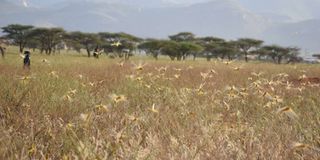Premium
Fao warns of second, severe locust invasion in Kenya

A swarm of locusts at Lengusaka area in Samburu East in January 2020.
The Food and Agriculture Organisation (Fao) has asked the government to step up its preparedness to deal with a second locust invasion expected in a week’s time.
The warning comes even as some of the counties in northern Kenya continue to battle immature swarms wreaking havoc on grasslands, threatening food security for them and their livestock.
Some mature swarms from the previous generation in Somalia continue to invade the northern and coastal counties with egg laying having already taken place near Tana River County, creating fears that it could have also occurred in other affected counties.
The expected invasion in mid-December could be worse than Fao had projected weeks ago, following Cyclone Gati.
It struck Somalia a week ago, hastening the maturity of the swarms in the country.
Mature swarms are present in northeast Somalia where they are expected to lay eggs in areas that have received heavy rains due to the cyclone. This will cause hatching and band formation in the coming few days.
Fao said substantial breeding and a large number of hopper bands continue to develop in eastern Ethiopia and central Somalia where ground and aerial operations to fight the locusts are under way.
Swarms’ migration
Successive waves of immature swarms are expected to migrate south to southeast Ethiopia and south Somalia and invade northeast Kenya and then spread to northern and central counties.
“Intensive survey and control operations should be maintained in Ethiopia and Somalia. Extreme vigilance and preparedness is required in Kenya,” Fao said in the December 3 update.
The agency previously warned that the risk remained high in northern Kenya where existing locusts could lay eggs in sandy areas with hatching and band formation expected to start this week.
Already, eight counties are battling fresh invasions by small mature swarms that migrated from Somalia two weeks ago and continue to devour vegetation and grasslands.
The affected counties are Mandera, Isiolo, Wajir, Tana River, Lamu, Garissa, Kitui and Taita-Taveta.
Destruction of pasturelands
Samburu, which has been battling infestations throughout the year, is dealing with second generation hoppers that continue to cause destruction on pasturelands and which could ignite resource-based conflicts.
Samburu Special Programmes Chief Officer Daniel Leisagor said continued destruction of grasslands will cause hunger and threaten food security for the communities that are predominantly pastoralist.
The government faces a difficult task in dealing with the impending invasion which will cause further suffering to Kenyans who have been adversely affected by the Covid-19 pandemic.
Officials are concerned that most of the swarms, which are now maturing, could start breeding any time due to the cool environment occasioned by the ongoing short rains.
Having been faced with resource constraints in dealing with past invasions that affected over 28 counties, the government faces an uphill task in ensuring regular pesticide supplies, adequate equipment and personnel to deal with the menace.





